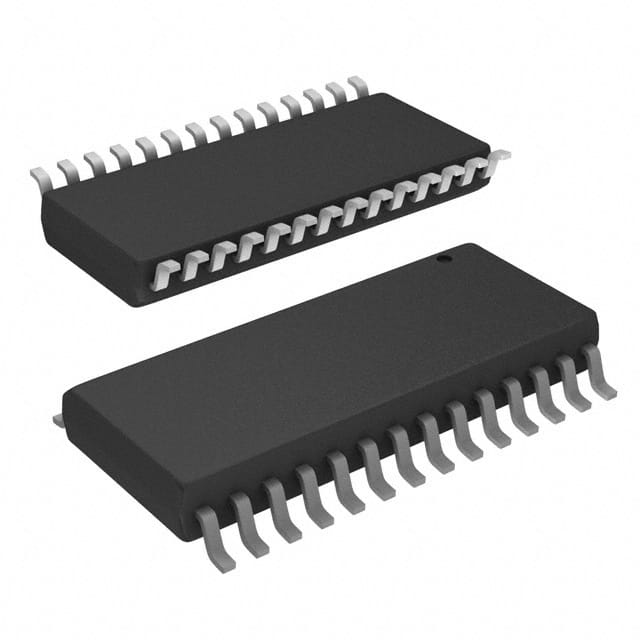Xem thông số kỹ thuật để biết chi tiết sản phẩm.

PIC16C73B-20/SO
Product Overview
Category
The PIC16C73B-20/SO belongs to the category of microcontrollers.
Use
This microcontroller is widely used in various electronic applications that require embedded control and processing capabilities.
Characteristics
- Low power consumption
- High-performance RISC architecture
- Enhanced features for efficient code execution
- Wide operating voltage range
- Large program memory capacity
- Flexible input/output options
Package
The PIC16C73B-20/SO is available in a small outline (SO) package, which provides ease of integration into compact electronic devices.
Essence
The essence of the PIC16C73B-20/SO lies in its ability to provide reliable and efficient control and processing capabilities in a compact form factor.
Packaging/Quantity
This microcontroller is typically packaged in reels or tubes, with each containing a specific quantity of units. The exact packaging and quantity may vary depending on the supplier.
Specifications
- Operating Voltage: 2.0V to 5.5V
- Maximum Clock Frequency: 20 MHz
- Program Memory Size: 4 KB
- Data Memory Size: 192 bytes
- Number of I/O Pins: 22
- Analog-to-Digital Converter (ADC): 8 channels, 10-bit resolution
- Timers: 3 timers/counters
- Communication Interfaces: USART, SPI, I2C
Detailed Pin Configuration
The PIC16C73B-20/SO has a total of 28 pins, each serving a specific purpose. The detailed pin configuration is as follows:
- VDD - Power supply voltage
- RA0/AN0 - Analog input or digital I/O
- RA1/AN1 - Analog input or digital I/O
- RA2/AN2 - Analog input or digital I/O
- RA3/AN3 - Analog input or digital I/O
- RA4/T0CKI/C1OUT - Timer0 clock input or digital I/O
- MCLR/VPP - Master Clear input or programming voltage
- VSS - Ground
- RB0/INT - External interrupt or digital I/O
- RB1/SDI/SDA - Serial data input or digital I/O
- RB2/SDO/SCL - Serial data output or digital I/O
- RB3/PGM - Programming mode select
- RB4/PGC - Programming clock
- RB5/PGD - Programming data
- RB6/PGM - Programming mode select
- RB7/PGC - Programming clock
- RB8/PGD - Programming data
- RC0/T1OSO/T1CKI - Timer1 oscillator output or clock input
- RC1/T1OSI/CCP2 - Timer1 oscillator input or CCP2 module
- RC2/CCP1 - CCP1 module
- RC3/SCK/SCL - SPI/I2C clock
- RC4/SDI/SDA - SPI/I2C data
Functional Features
The PIC16C73B-20/SO offers a range of functional features that enhance its performance and versatility:
- High-performance RISC architecture allows for efficient execution of instructions.
- Enhanced instruction set provides a wide range of operations for various applications.
- Flexible input/output options enable seamless integration with external devices.
- On-chip peripherals, such as timers and communication interfaces, simplify system design.
- Low power consumption ensures energy-efficient operation in battery-powered applications.
Advantages and Disadvantages
Advantages
- Compact form factor enables integration into space-constrained designs.
- Wide operating voltage range allows for compatibility with different power sources.
- Large program memory capacity accommodates complex applications.
- Enhanced features optimize code execution and improve overall performance.
- Low power consumption prolongs battery life in portable devices.
Disadvantages
- Limited data memory size may restrict the storage of large datasets.
- Lack of advanced communication protocols, such as Ethernet or USB, may limit connectivity options in certain applications.
- The absence of hardware encryption modules may pose security challenges in sensitive applications.
Working Principles
The PIC16C73B-20/SO operates based on the principles of a RISC (Reduced Instruction Set Computer) architecture. It executes instructions stored in its program memory to perform various tasks. The microcontroller interacts with external devices through its input/output pins, enabling control and communication with the surrounding system. By utilizing its on-chip peripherals and flexible I/O options, the PIC16C73B-20/SO can efficiently process data and execute commands according to the programmed instructions.
Detailed Application Field Plans
The PIC16C73B-20/SO finds
Liệt kê 10 câu hỏi và câu trả lời thường gặp liên quan đến ứng dụng PIC16C73B-20/SO trong giải pháp kỹ thuật
What is the operating voltage range of PIC16C73B-20/SO?
- The operating voltage range of PIC16C73B-20/SO is 2.0V to 5.5V.What are the key features of PIC16C73B-20/SO?
- Some key features of PIC16C73B-20/SO include 28-pin SOIC package, 20 MHz clock speed, and 14 I/O pins.Can PIC16C73B-20/SO be used in battery-powered applications?
- Yes, PIC16C73B-20/SO's low operating voltage range makes it suitable for battery-powered applications.What programming language can be used to program PIC16C73B-20/SO?
- PIC16C73B-20/SO can be programmed using assembly language or high-level languages like C.Is PIC16C73B-20/SO suitable for real-time control applications?
- Yes, PIC16C73B-20/SO's fast clock speed and versatile I/O make it suitable for real-time control applications.What communication interfaces does PIC16C73B-20/SO support?
- PIC16C73B-20/SO supports serial communication interfaces such as USART and SPI.Can PIC16C73B-20/SO be used in temperature-sensitive environments?
- Yes, PIC16C73B-20/SO has a wide operating temperature range, making it suitable for temperature-sensitive environments.What development tools are available for PIC16C73B-20/SO?
- Development tools such as MPLAB IDE and PICkit programmers are available for programming and debugging PIC16C73B-20/SO.Are there any application notes or reference designs available for PIC16C73B-20/SO?
- Yes, Microchip provides application notes and reference designs for various applications using PIC16C73B-20/SO.Can PIC16C73B-20/SO be used in automotive electronics?
- Yes, PIC16C73B-20/SO's robust design and wide operating voltage range make it suitable for automotive electronics applications.

